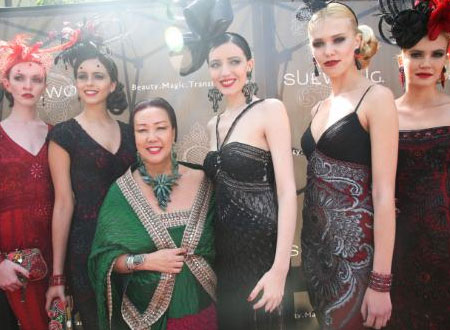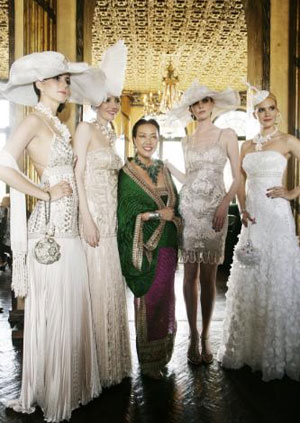Fashion designer Sue Wong used her historic Hollywood home, The Cedars, to showcase her My Fair Lady-inspired Fall 2011 Collection Friday as part of Los Angeles Fashion Week. Wong’s models roamed the estate in Wong’s creations as guests enjoyed a champagne brunch.
Wong’s collection features ornate gowns and cocktail dresses in rich satin, flowing chiffons and laces, embellished with Edwardian inspired beadwork, intricate embroidery and delicate applique with skirts of organza and ostrich feather. The scene was intended to evoke Sir Cecil Beaton’s costume in the racetrack scene of the 1964 film starring Audrey Hepburn in the title role.
Beautiful, romantic and elegant pieces in the collection “can transform any woman into a goddess, enchantress and duchess,” said Wong.
Guests did their part by donning their favorite ascot hats and Sue Wong’s gowns. Actress Tippi Hedren attended in a fedora to suggest Professor Higgins.

“I think the collection is probably one of the most beautiful in the whole world no matter how long you go back in the history of fashion,” said Hedren. “Sue Wong has such an air of elegance, glamour; everything you could possibly want.”
“I believe that clothing has the ability to empower and transform a woman into the fantasy of her choice,” says Wong. Her motto — “Beauty. Magic. Transformation.” — echoes the film’s premise in which a ‘guttersnipe’ flower seller is transformed by Higgins into an elegant lady.
Sue Wong is known for designs that echoes period styles while achieving a fresh, modern spirit. They are sold in fine boutiques and department stores like Neiman Marcus, Saks Fifth Avenue, Bloomingdale’s and Nordstrom and in more than 27 countries globally. Sponsors for the event included Fiji Water, PAMA Liqueur, South Coast Winery Resort and Spa, Napoleon Perdis, Hair By Sheena Mi Lee, Michael Antonio, Izze Sparkling Juice, What’s Ur Bag, Ardell, and China Glaze.
Sue Wong was born in rural communist China in 1949. Her family first escaped to Hong Kong before managing to immigrate to the United States in 1955.
While growing up in California she had her sights set on a career in fine arts. She won a scholarship to the prestigious California Institute of the Arts after high school, but her parents kept her from attending because they wanted her to become an accountant or a teacher.
Ultimately, however, Wong defied her parents’ wishes and enrolled at Los Angeles Technical College. Within a month she won a scholarship from Arpeja, a hip fashion company for younger women. Within a year, when she was only 18, Wong ended her schooling to take a full-time job as a designer in Arpeja’s sportswear division.
At first she found the business to be a nightmare. In 1970, after only about a year at Arpeja, Wong decided to start up her own company with a girlfriend.
“I wanted to escape the horrors of the garment business and find my own personal style,” Wong recalled. She soon learned that running a new fashion house was even tougher than working for an existing fashion house. In 1974 she returned to Arpeja as head designer for Young Edwardian. That job required her to do five lines a year with over 100 dresses for each collection. “The work load is heavy but the designing part comes easy,” she said.
After she became lead designer in 1977, Arpeja’s sales jumped to $51 million from only $3 million in 1974.
At the time Wong claimed that it didn’t bother her to be designing anonymously for Arpeja.
“I don’t care [because] I think most of the people in the garment business are hustlers and whores,” she said.
But by 1979 Wong decided to go independent again with her own name on the company signage. Her business strategy was to do the designing in Los Angeles but have the labor-intensive work down in China. That proved to be the right strategy for keeping the company profitable.
Wong is married to artist and textile designer Ralph Homann who eventually ended up staying home to raise their two children. “He’s very good at it,” Wong said. “Better than I would be.”


